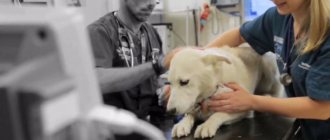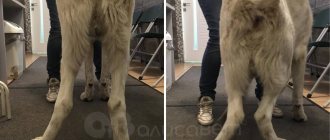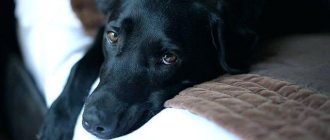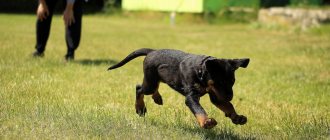Quite often, owners are faced with the problem of lameness in their dogs. The causes of the disease can be very diverse, for example, injury or joint disease. Lameness is a partial or complete loss of mobility that can affect one or both legs. The symptom is detected immediately, as the dog’s gait changes, which is expressed in the asymmetry of the pet’s movements. Lameness itself is not a disease. It is rather a symptom indicating some other problem.
Lameness is a sign of internal impairment or external damage
Possible causes of lameness in dogs
Factors that provoke lameness can be divided into two groups:
- External.
- Internal.
The first category includes:
- Injuries. Moreover, they often go unnoticed - bruises, dislocations, closed fractures, a bite from another animal. The dog limps especially noticeably after lying down or sleeping.
- Bite of a stinging insect - bee, wasp, bumblebee. Also, a dog's paw can become a target for attack by ticks and other ectoparasites. Less commonly, the cause of lameness may be the bite of a snake, including a non-venomous one.
- Broken claw. Such injuries are characterized by changes in gait and bleeding.
- Splinter. Dogs love to explore the territory, so they often stumble upon dangerous objects. Especially when it comes to suburban areas. Typically the splinter penetrates the pad or area between the toes.
- Uncomfortable clothing that restricts movement.
- Uncomfortable position during a long sleep - the pet can simply lie down with its front or back paw.
The group of internal causes includes physiological disorders:
- Rheumatoid arthritis.
- Crick.
- Dysplasia of the hip or knee joint. This is a genetic disorder that can cause muscle atrophy.
- Tendon rupture. The flexor muscles are most often affected. If left untreated, chronic inflammation develops and fibrous tissue forms that connects the tendons. A scar appears, causing the tendons to shorten and movement to become limited. With this diagnosis, the pet rests on the phalanges of the fingers, and not on the pads of the paws.
- Arthrosis. Large dogs are at risk because their joints experience increased stress, especially during puppyhood and in old age. In addition, males suffer from arthritis more often than females.
- Perthes disease. The head of the femur dies due to disruption of its nutrition.
- An unsuccessful injection can damage the sciatic nerve.
- Intervertebral disc disease. Dogs at risk include Welsh Corgis, Beagles, Dachshunds, Bulldogs, Poodles, Shih Tzus, and Pekingese.
- Wobbler syndrome.
- Wedge-shaped vertebrae syndrome.
- Fibrous-cartilaginous embolism.
- Spondymyelopathy.
- Pathologies of the peripheral nervous system (for example, degenerative myelopathy).
On a note. If neurological dysfunction is present, the dog may shake. Also, slight tremors can be a response to pain and weakness.
Rheumatoid arthritis in a dog
Joint dislocations and muscle strains
Muscle strain can occur when your pet falls or jumps. The most susceptible to this disease are dachshunds, pugs and other breeds with short legs. Also at risk are animals with a fragile constitution - miniature dogs (Chihuahua, Spitz, Yorkie, Chinese Crested). Overly active animals can suffer as a result of games and training.
Dislocation can occur either due to injury or due to genetic abnormalities. The latter include dysplasia of the hip or knee joint. Predisposing factors for the development of the disease are:
- poor nutrition;
- bad ecology;
- imbalance of physical activity (lack or excess).
On a note . Hip dysplasia is common in large breeds, while luxating patella usually occurs in small dogs.
Sprain in a dog
Consequences of injection and other manipulations
The causes of lameness in this case are associated with pinching or damage to the nerve at the time of injection. In addition, if we talk about antibiotics, such injections are very painful - so much so that they can cause short-term lameness in the pet.
Benign and malignant neoplasms
Benign tumors can be caused by the following reasons:
- fungal infections (skin itches, gets wet);
- allergy;
- kidney or heart disease;
- advanced dermatitis;
- burn, including chemical burn;
- ingrown claw.
Malignant tumors most often appear due to age-related changes.
Rheumatoid arthritis
It is an inflammation inside a joint. It can occur against the background of age-related changes, as well as with weakened immunity. Upon careful examination, you may notice slight swelling in the joint area, but if the internal joint is affected, the swelling will not be visible.
Other pathologies that cause lameness
Other pathological reasons that can cause lameness in a dog include:
- vitamin deficiency;
- dry pads;
- frostbite;
- diabetes;
- Vitamin deficiency can cause nutritional hyperparathyroidism in puppies.
To prevent your dog from breaking his nails, they need to be trimmed regularly.
How to correctly determine the cause of lameness
Regardless of the degree of lameness, the cause is determined by careful examination of the problem limb. If you cannot identify the disease on your own, you should contact a veterinary clinic. You will also have to go to the hospital if a serious pathology is detected.
On a note. When examining the paw, you must carefully monitor the animal's reaction.
The following symptoms indicate the severity of the problem:
- the dog tries to tuck his paw when walking;
- cannot fully lean on a limb;
- decreased activity;
- The dog has stopped jumping and cannot go up or down stairs.
In this case, the paw may not hurt at all.
At the clinic, the doctor carefully examines the dog, collects anamnesis and, based on the results, prescribes a surgical and neurological examination. Further, X-rays, MRI, ultrasound, computed tomography, arthroscopy may be required.
Features of home diagnostics
If the dog’s previously light and springy gait suddenly changes for the worse, it’s easy to notice. There is an effective way to check the condition of the pet: wet the surface and walk the dog along it, then analyze the step by measuring the distance between the tracks. It is also necessary to pay attention to the position of the paws. Signs of problems indicate:
- short step;
- extension of the limb or rotation inward;
- if the leg is sick, then the mark will be weak.
For further diagnosis, the dog is taken to the veterinary clinic.
Types of injuries
The dog is limping on its front leg without visible damage
Some owners are not only unaware of what to do if their dog is limping on a hind leg without visible damage, but they are also unaware of the types of lameness.
If your dog is limping on its hind leg, you should not delay diagnosis.
In addition to the degree of this disease, there are several more varieties:
- Leaning limb. In this case, the dog can still lean on the damaged paw, but does not do so completely. In any case, she tries to put her weight on her healthy paw.
- Hanging paw. What is typical is that if a dog stands on all 4 paws, this is not accompanied by pain. However, it comes as soon as the dog raises its paw. But in other cases, the dog simply holds the sore limb suspended, that is, it seems to rest in the air.
- Intermittent variety. Here, in the process of lameness, one paw replaces the other, which manifests itself when the dog runs. However, during normal walking, the pet walks with an even gait. Often owners think that the animal is just pretending. In reality, this is due to a number of reasons.
- Mixed lameness. With such a problem, it is equally difficult for a dog not only to step on a limb, but also to lift it.
Note! Not every dog owner is able to accurately determine lameness, since it varies. Only a veterinarian can identify serious problems after diagnosis and correctly select a course of therapy.
How to prepare for a visit to the veterinary clinic
The first thing to do is to collect as much information as possible about the pet’s condition:
- the dog presses its back paw strongly or weakly;
- does she experience pain when palpating the problem area;
- how much the limb hurts while walking (whether the pet whines, shows aggression, etc.);
- what were the previous events (fights, walks in abandoned areas, vaccination, etc.) - the answer to this question will help to understand what could presumably have caused the lameness.
On a note! Before examination, it is recommended to put a muzzle on the dog.
Examination of a sore paw
What to do?
Therapeutic measures depend on what exactly caused the lameness. A sick animal is advised to reduce exercise and activity. If necessary, a special diet is prescribed. If the provocateur was inflammation, then the veterinarian recommends the use of Ketofen, Rimadyl.
Ketofen is used if inflammation has been detected.
Very severe cases can only be cured surgically.
Surgery is prescribed for a cruciate ligament rupture.
If the claw is broken
It is completely removed at the veterinary clinic . If blood flows from the wound, then it must be stopped. This can be done using a special pencil or antibacterial soap.
You can stop the bleeding using a special pencil.
The dog recovers quickly after removal. A new “nail” grows 3–4 months after surgery.
Muscle strain
The main symptoms of sprains are swelling and inflammation. A cold, or better yet, ice compress is applied to the affected limb. Procedure time: 15–20 minutes. Cold causes blood vessels to constrict. Against this background, swelling decreases.
For muscle strain, apply a cold compress.
You need to make such compresses 3 times/24 hours. The duration of the therapeutic course is 48 hours.
Treating a Minor Cut
The wound is washed with a disinfectant . Hydrogen peroxide is usually used for this purpose. After this, any antiseptic is applied to the cut.
A small cut should be treated with hydrogen peroxide.
The damaged limb must be wrapped in a sterile bandage, put on a sock and secure it carefully.
If the cut is deep enough, it is best to take your pet to a veterinarian.
Help with myositis
Myositis refers to inflammation of muscle tissue. Impaired gait is accompanied by convulsions. The main provocateur of this condition is hypothermia. Myositis is often diagnosed in dogs living in an enclosure.
Hypothermia can cause myositis.
You can help your dog by providing him with warmth. Massage manipulations bring great benefits to the limbs.
Help with sprains
A cold compress is first applied to the affected limb, then a pressure bandage is applied. If the pet's condition remains the same, it is necessary to show it to a veterinarian.
A pressure bandage is applied when the ligaments are sprained.
This is a rather dangerous condition that can lead to arthritis.
Preventive actions
The following steps will help you avoid lameness:
- Proper animal care.
- Balanced diet.
- Regular examination of the limbs (at least once a week). Paws must be examined after going to the forest or mountains.
- In winter, small dogs should wear special shoes.
- Timely trimming of nails.
- Washing paws with soap after every walk, removing dirt from the spaces between the toes.
- Trimming the fur between the fingers.
- Tracking the degree and complexity of physical activity.
- Compliance with breed breeding rules (closely related unions are excluded, animals with hereditary diseases should not participate in breeding).
- When walking, avoid dangerous places (where there are a lot of stones, glass, branches, etc.).
- Minimize contact with other animals.
If lameness is detected in a pet, the problem should not be ignored under any circumstances. It is better to show the dog to a veterinarian and make sure that there is no cause for concern, or if a serious pathology is detected, start treatment on time.
Features of treatment for limb failure
To identify pathology, the veterinarian carries out:
- visual examination - assessment of general condition, checking sensitivity, reflexes and pain reactions;
- X-ray examination or MRI;
- myelography - x-ray examination with a contrast agent;
- general clinical urine and blood tests.
Further treatment tactics vary significantly depending on the disease that caused the immobility.
Treatment is usually prescribed:
- Operational.
Surgery is performed to eliminate the provoking factor.- Physiotherapeutic.
Complements surgical and drug treatment.- Medication.
Special medications are prescribed, different for each type of disease.It can be:
- antibiotics;
- antispasmodics;
- analgesics;
- non-steroidal anti-inflammatory drugs;
- immunomodulators;
- medications that improve nerve conduction, blood supply and regeneration.
Regardless of the type of disease and prescribed therapy, it is necessary to create a special diet. All products should be easily digestible and nutritious, contain a lot of calcium, selenium, sulfur, protein, and fatty acids.











